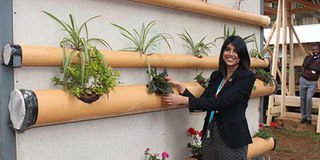Climate-smart housing technologies for urban dwellers

Sameera Chukkapali, an architect, showcases urban gardening during the 1st UN Habitat Assembly in Nairobi last month. PHOTO | COURTESY
What you need to know:
- The climate-smart houses provide protection against vagaries of nature such as flooding and heatwaves while being water and energy efficient.
- With millions of people migrating from rural to urban areas every year for employment opportunities, experts estimate that the world urban population might hit six billion by 2050.
Techpreneurs at the 1st UN Habitat Assembly, the first big inter-governmental forum on urban development, which was held in Nairobi last week, showcased a number of new housing technologies which could transform the face of urban housing in the future.
From embedded solar roofing materials, use of recycled materials for walls to use of locally available eco-friendly materials, modern home designers are incorporating climate-smart technologies in home building to cope with existing climatic conditions.
Changes in climate, according to experts, will affect local weather patterns and impact many people’s livelihoods.
The climate-smart houses therefore provide protection against vagaries of nature such as flooding and heatwaves while being water and energy efficient.
Due to climate change, many buildings in the future risk collapsing or deteriorating due to flash floods, storms or deteriorating indoor temperature unless they are designed to withstand such impacts.
GARDENING
Sameera Chukkapali, an architect at Needlab and Vishaka, who exhibited a climate-smart house built of steel columns, clay, recycled plastic boards and an embedded solar roof, says the design allows the homeowner to generate his/her own electricity and harvest water while at the same time protect the home from fluctuating temperatures.
The house also has a hanging garden where crops or flowers are planted in PVC pipes.
“The hanging garden could be attached to the wall for thermal cooling, aesthetics or to provide food for the home owner,” she explained. The home approximately costs Sh600,000.
The architect further explained that the garden can be established inside or outside the house.
In indoor gardening, she pointed out, thinner pipes and herbs such as mint, basil and coriander are recommended.
“We design resilient long-lasting houses. The houses measure eight metres by three metres. For every country, we use locally available materials such as clay, sand or mud,” Chukkapali said.
The firm has put up a similar building at a school in Nairobi, which serves as a library.
TIMBER SUPPLY
Such a building, she says, takes less than 72 hours to put up.
Besides using recycled materials, other technologies involve using timber to put up the floor and walls. Only the foundation of the house is constructed using concrete.
Arne Olsson, a Swedish home developer and an exhibitor at the conference, said his company has constructed an eight-storey wooden building in Stockholm, Sweden.
“This type of building is quite cool, smells good and is faster to build,” he says.
Construction of such houses however requires a properly organised forestry sector to ensure sustainable wood harvesting.
“Timber is a renewable material; so people must plant trees as they harvest to avoid deforestation. Timber can be used to develop decent houses especially in circumstances where houses are urgently needed,” Olsson explained.
MIGRATION
With millions of people migrating from rural to urban areas every year for employment opportunities, experts estimate that the world urban population might hit six billion by 2050.
The influx will trigger a housing crisis and an upsurge of informal settlements. In Kenya, the population of slum dwellers has recently risen to 6.4 million, according to the UN Habitat.
Generally, the cost of living in urban areas is also rising by the day, driven by a number of factors such as cost of food.
But with effective urban farming technologies, city dwellers can grow their own vegetables in the tiny spaces available to them.
Michael Njeri, an extension officer at Miramar International College, which offers a programme on urban farming, says urban dwellers can grow vegetables in vertical gardens that use hydroponic technology, which costs less than Sh40,000. A unit can hold about 100 plants.
“We have partnered with KCB foundation, which gives start-up loans to youth between 18–30 years following a three-month training on urban farming at our institution,” Njeri said.
HYDROPONIC TECHNOLOGY
The technology can be used on the backyard, or on the balcony. The vegetables are planted using volcanic rocks or hydroponic technology, where the crops are grown in water rich in minerals instead of soil.
“Hydroponic fodder mature within seven days, and can be used as animal fodder. A cow feeds on a tray per day. When feeding it to chicken, the fodder is harvested after four days,” he explained.
Experts at the UN Habitat Assembly, which aimed to promote urban developed agenda, agreed that rapid urbanisation will need robust innovations to enhance public mobility, affordable and decent housing, and access to social amenities and food.
The theme was, “Innovation for a Better Quality of Life in Cities and Communities”.
Joyce Msuya, acting Executive Director of the United Nations Environment Programme, said that there is need for collective efforts in managing urban growth.
“These trends call for collective efforts to be innovative and bold in the way we approach and implement urban growth so that future cities provide opportunities and better living conditions for all,” Msuya said.





